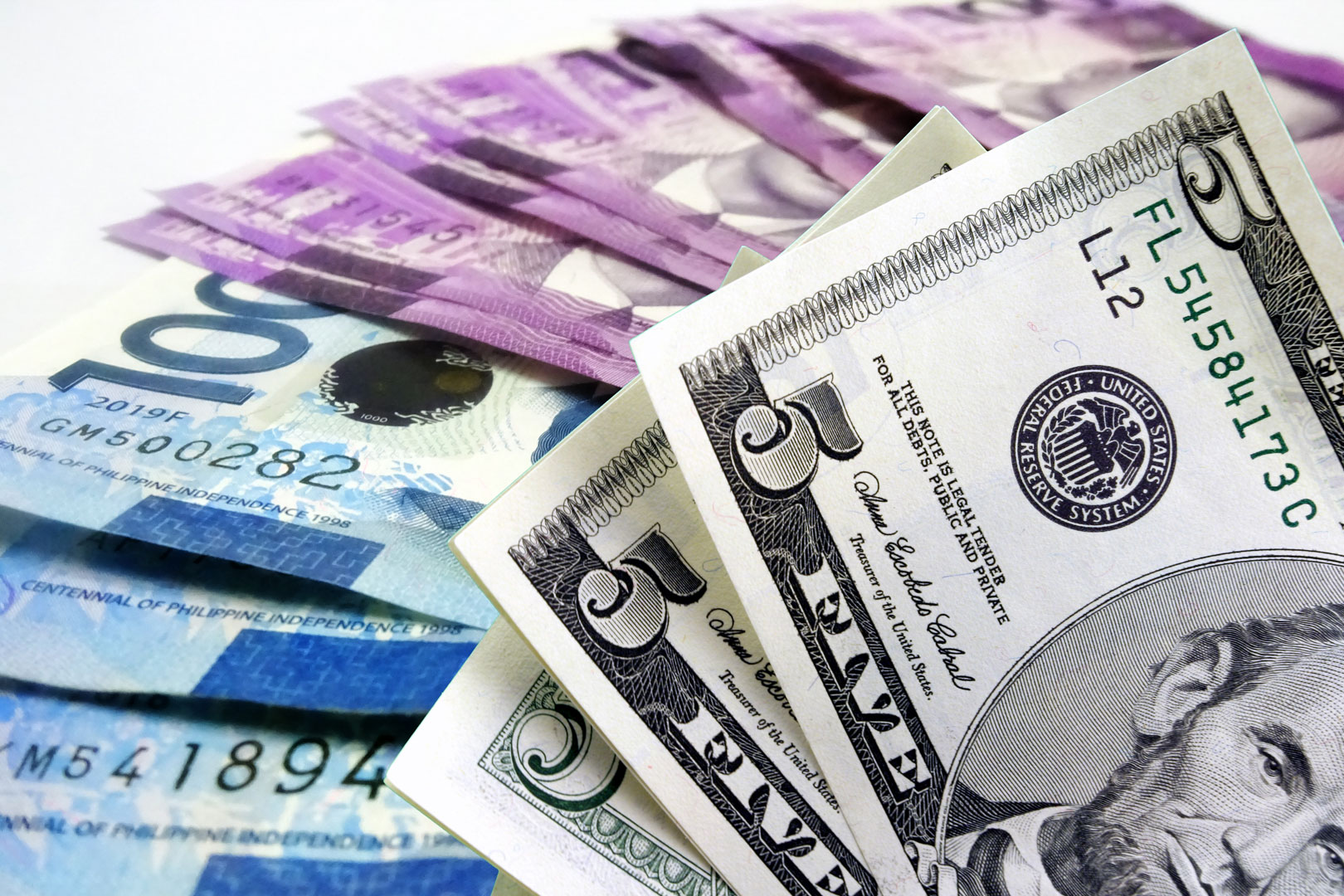
By Luisa Maria Jacinta C. Jocson, Senior Reporter
THE PHILIPPINE PESO is expected to continue its rally against the dollar until early 2026 amid cooling inflation, expectations of further policy easing by the central bank and improving trade and investment flows.
“We continue to forecast the peso to strengthen against the US dollar, reflecting low inflation, continued space for rate cuts, foreign direct investment improvement and a likely trade deal with the US, coupled with strong infrastructure spending,” MUFG Global Markets Research said in a report.
The Tokyo-based research firm expects the peso to settle at P55.60 against the greenback by the third quarter and strengthen further to P55 by the fourth quarter. It sees the peso hitting P54.50 against the dollar by the first quarter of next year.
The peso closed at P55.721 a dollar on Tuesday, weakening by 2.1 centavos from its P55.70 finish a day earlier.
It has been trading at the P55-a-dollar level since the end of April, hitting a near two-year high last month as the dollar came under pressure after Moody’s Ratings cut the US’ triple-A rating.
“Part of this change reflects global factors such as the US-China tariff pause, with our expectation now for more modest Chinese yuan weakness,” MUFG said.
“More importantly, domestic inflation pressures in the Philippines have also been softer than expected, and this provides BSP (Bangko Sentral ng Pilipinas) further space to cut rates to support the economy,” it added.
The dollar fell to a six-week low as erratic US trade policies clouded over markets, and investors turned defensive ahead of key developments later in the week, Reuters reported.
MUFG projects Philippine inflation to average 1.8% this year, below the central bank’s 2-4% target and 2.3% forecast. Inflation averaged 2% in the first four months.
This was driven by expectations of “declines in domestic rice prices, manageable oil prices, coupled with reduced risks to transport fare and electricity price hikes,” MUFG said
“As such, we continue to forecast BSP to remain dovish and cut the policy rate by a further 75 basis points (bps), bringing it to 4.75% by end-2025,” it added.
The Monetary Board will hold its next rate-setting meeting on June 19. BSP Governor Eli M. Remolona, Jr. has said a 25-bp rate cut remained “on the table” this month.
The central bank has lowered borrowing costs by 100 bps since it started its easing cycle in August last year.
“We also implicitly assume a trade deal with the US will be reached, and for average tariffs on the Philippines to fall below the 17% reciprocal level,” MUFG said.
The pickup in foreign direct investment (FDI) flows and strong infrastructure spending would also aid the peso, it added.
FOREX RISKSHowever, the research firm cited risks to the peso’s performance, including a US plan to tax remittances from non-US citizens, slowing FDI approvals and domestic political risks.
“We are reluctant to forecast further peso strength despite an expectation for the US dollar weakness for [these] reasons,” it said.
The proposed 3.5% US tax on remittances could cut the share of Philippine remittances in economic output by 0.1%, MUFG said.
The US is the Philippines’ top remittance source, accounting for about 40% of the total.
“Our base case is for the recent Senate election results to slow the pace of reforms, but we think it is unlikely to change the trajectory of policy, including on infrastructure build-out,” it said.
John Paolo R. Rivera, a senior research fellow at the Philippine Institute for Development Studies, also flagged risks to the peso outlook.
“The P55 level may persist in the short term, but volatility remains possible depending on several domestic and global factors,” he said in a Viber message.
He expects the peso to trade at P54.50 to 56.60 against the dollar in the second half, barring any shocks.
“The currency’s relative strength reflects improved dollar inflows, low inflation and a dovish stance from the BSP,” he said. “A mild depreciation bias is possible if the BSP begins cutting rates ahead of the US Federal Reserve or if imports surge without offsetting inflows.”
Reinielle Matt M. Erece, an economist at Oikonomia Advisory and Research, Inc., said the recent dollar weakness was due to investors selling off their assets.
“As inflation risks and credit worries in the US persist, we may see the exchange rate continuing to strengthen,” he said in a Viber message.
The dollar index, which measures its performance against six other major currencies, eased 0.6% and at 98.75 was just shy of the three-year low of 97.923 touched in late April, Reuters reported.
It has been whipsawed for weeks by US President Donald J. Trump’s on-again-off-again trade war, and investors have been questioning the currency’s safe-haven status as a flare-up in tensions stokes worries of a potential US recession.
“However, a downside risk on the exchange rate is if we pursue a dovish monetary policy strategy, while the US may pause rate cuts or raise them to avoid capital outflows and inflation,” Mr. Erece said. “This may put upward pressure on the exchange rate.”